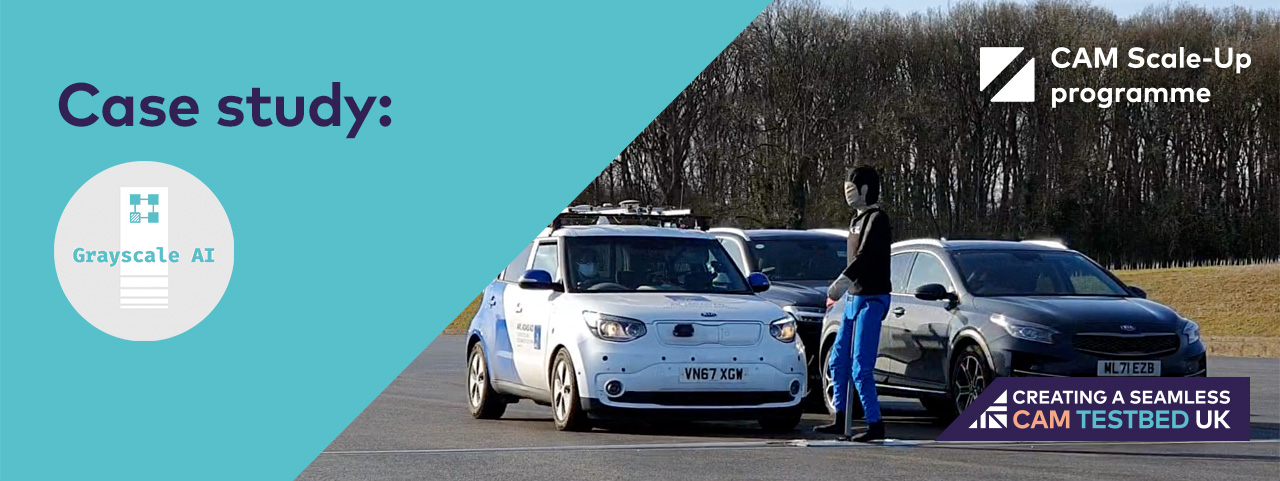



Grayscale AI and the CAM Scale-Up programme
Grayscale AI and the CAM Scale-Up programme

Grayscale AI is building neuromorphic software that integrates with existing tech to provide human-like precision and understanding to navigating the roads. It’s faster, more energy efficient and has the ability to perform well in difficult conditions.
Grayscale AI is a tech start-up dedicated to creating optimization-driven AI, with the intention of mimicking a human’s neural network. Their solution leverages neuromorphic cameras, which detect changes in the environment, a contrast to traditional cameras, which take continuous snapshots of a scene leading to an excess of redundant information and high data output. The tech stack offers a superior processing time that’s both cost and energy efficient.
It’s spearheaded by Dragos Stanciu, a software developer with a passion for neuroscience. Dragos channelled his interest into computational neuroscience, creating mathematical models to represent how the brain works, eventually applying this knowledge to robotics and neuromorphic cameras.
Dragos explains:
When we talk about neuromorphic computing, it’s a completely new computing paradigm, but there’s a huge opportunity to move technology, and the market, towards this new approach to processing data and interacting with the environment.”
Now he continues to grow the company, with the aim to add the best and brightest in computer vision, computational neuroscience and robotics to further test the limits of this cutting-edge technology and achieve increasingly more dynamic, efficient neuromorphic vision solutions.
What makes Grayscale AI special?
Grayscale AI realised that the automotive industry can benefit from a greener and smarter solution to spatially understanding environments. By using neuromorphic computing, they can create a cutting-edge solution that can dramatically outperform traditional sensors, as it has the capacity to process complex scenarios with little input needed. It has the potential to be highly efficient at detecting and avoiding hazards and promises to perform well even in the most challenging, vision-obscuring environments.
Neuromorphic chips are fundamentally different from the chips currently used in smartphones and laptops. The algorithm uses computer science to reframe classical logic-based AI into a more robust and flexible solution.
Traditionally computers split up the CPU and the RAM, with the data moving between them, however neuromorphic chips house the computation and memory in one piece of hardware.
These chips use “spiking neurons” as an element of computation. Instead of computing in a rigid binary “vocabulary” of 1s and 0s, the “neurons” compute in a more flexible manner. Also, unlike CPUs, these chips don’t have a central clock to synchronise their computing steps, which allows the “neurons” to operate without a predefined order.
In a neuromorphic camera, each pixel is independent in picking up the changes in the environment. It combines low-power AI computing, local interpretation and analysis, and achieves negligible standby consumption, making it up to 10,000 times more efficient than its counterpart. This creates a more sustainable solution that has a lower carbon footprint. It also increases the speed of performance and crucially, it’s reactive to the environment. Instead of processing information sequentially, it can emulate and learn algorithms at silicon level – all it needs is the stimuli to learn a pattern from. The sensors on the camera also have a high dynamic range which enables it to work well in low light conditions.
When applying this to the automotive industry it can be programmed to detect vulnerable road users like pedestrians and cyclists in microseconds.
Grayscale AI's testing journey
Testing accelerated product development by 9 months.

Being involved in the Zenzic CAM Scale-Up programme has primarily afforded Grayscale AI the opportunity to gather a more extensive dataset. They worked through a series of tests that increasingly challenged their system and its capacity to detect hazards in a variety of optimal and sub-optimal conditions, including testing the solution’s response in different light conditions and enclosed spaces. They collected a multi-sensor dataset including radar, camera and neuromorphic cameras, and benchmarked their performance against traditional computer vision algorithms.
They began controlled trials at AVL, a faculty within Midlands Future Mobility (MFM), and ASSURED CAV which functioned as a proving ground for custom and controlled test cases, before moving onto further testing at MFM and Smart Mobility Living Labs: London to strengthen their dataset on public routes and in urban environments. Testing a range of environments provided a more robust dataset against different weather, lighting and road conditions.
Dragos comments:
Working with the testbeds allowed us to gain access to specialised equipment that we otherwise wouldn’t have been able to conduct testing on. I estimate that not only has it accelerated our product roadmap by around 9 months, it also allows us to better illustrate the value proposition for new clients and investors.”
What would success look like:
In the short term, success will mean integrating vehicles with their solution in the most effective way possible. It will enable Grayscale AI to position themselves as market leaders in the UK and demonstrate the potential for neuromorphic AI within the automotive space.
Additionally, the Zenzic CAM Scale-Up programme will provide them with opportunities that are invaluable for accelerating their business growth, both through the providing the opportunity for more rigorous testing, which will improve datasets and help customers better understand the value proposition they offer, as well as enabling them to work with contacts that can help scale the business to the next level.
Programme results
Grayscale AI’s testing programme has resulted in business success across three core aspects.Development:
During the testing process Grayscale AI were able to undertake a number of key scenarios that put their software to the test and determine where their solution provides the most value.
Growth:
Grayscale AI attribute their involvement with Zenzic’s CAM Scale-Up programme with helping them gather probably the most comprehensive automotive event-based vision dataset worldwide, enabling them to improve and benchmark their product.
Market positioning:
Through exposure to the CAM ecosystem and access to CAM Testbed UK, Grayscale AI better understand how to position themselves in the automotive marketplace.
More SME case studies

Providing solutions for navigating challenging environments through high-accuracy geolocation technology.

Improving insurance savings and reducing accident rates through live GPS tracking.

Revolutionising the safety of vulnerable road users by using point-to-point radar technology.

The edge processing solution that provides in-depth insights into movement within cities.

Transforming how motor claims are processed through their connected claims platform.
Find out more about the
CAM Scale-Up programme
discover more

Talk to us
Want to talk about connected and automated mobility in the UK and see how Zenzic can help you?
{{ teamMember.name }}
{{ teamMember.title }}
